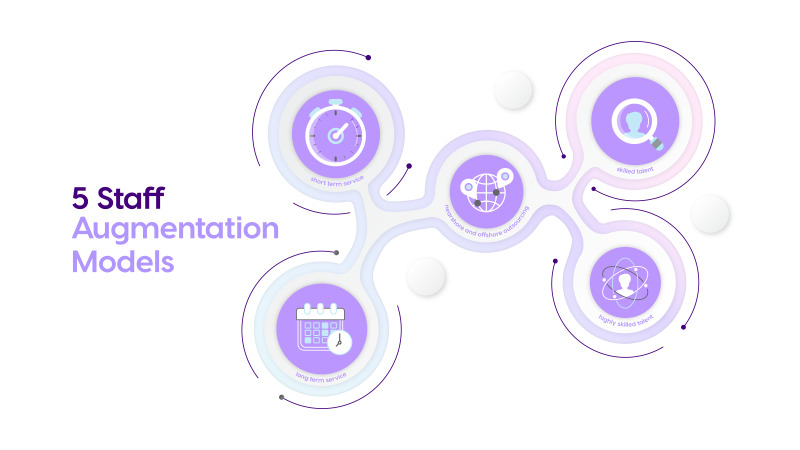What is Resource and Staff Augmentation?

Updated June 13, 2023
In the wake of pandemic-related staff shortages, many companies turned to resource and staff augmentation to get the help they need. Now, as many companies face organizational restructuring and layoffs, they’re taking the same approach to accommodate consolidated or smaller teams and shrinking budgets. Staff augmentation can be a good strategy for giving your team a much-needed boost when hiring full time employees isn’t an option, for one reason or another.
In this post, we’ll explain what the staff augmentation model is, who uses it, pros and cons, and more. Resource and staff augmentation isn’t the right approach for everyone, but hopefully after reading this article, you’ll be better informed to decide if it’s right for you.
Table of contents
- What is staff and resource augmentation?
- Best staff augmentation services for tech talent
- Choosing the right staff augmentation model
- When to use resource and staff augmentation
- Pros and cons of staff augmentation
- Common misconceptions about staff augmentation
- Resource and staff augmentation vs. other models
- The right partner makes all the difference
What is resource and staff augmentation?
Resource and staff augmentation is an approach to staffing that involves hiring temporary workers to provide extra lift or fill a talent gap or skill gap in your team. Workers hired in this capacity are usually independent contractors whom a company engages for short or long term projects. Some companies also hire them for a set duration of time or indefinitely for a certain number of hours every week.
This type of staffing had been growing in popularity in recent years, and the COVID-19 pandemic threw that trend into high gear. Faced with staffing shortages and budget cuts, many companies—especially those in the tech industry—found it made more sense to engage temporary tech talent for certain projects and highly specialized skill sets than to hire new full time employees. Thus, staff augmentation entered the mainstream, giving employers more flexibility and agility in regard to hiring.
Hire an AWS developer →
Best staff augmentation services for tech talent
Ratings are accurate as of the date of most recent update but subject to change over time.

NerdRabbit
starstarstarstarstar_half (33 Google reviews*)
4.9 out of 5
Overview
Through Nerdly by NerdRabbit, organizations get access to cloud, IT, and marketing talent available for hourly, project, and contract-based work. All professionals available for hire on Nerdly are US-based and pre-vetted by our team of cloud-certified cloud recruitment consultants. NerdRabbit also offers nearshore outsourcing services through our on-the-ground partners in Buenos Aires, Argentina.

StartupSoft
starstarstarstarstar (18 Clutch reviews)
5 out of 5
Overview
StartupSoft provides staff augmentation services to tech startups from Silicon Valley and other tech hubs across the US and Canada. It also operates R&D centers in Europe and South America.

X-Team
starstarstarstarstar_half (6 Clutch reviews)
4.9 out of 5
Overview
StartupSoft provides staff augmentation services to tech startups from Silicon Valley and other tech hubs across the US and Canada. It also operates R&D centers in Europe and South America.

Digiryte
starstarstarstarstar_half (41 Clutch reviews)
4.8 out of 5
Overview
Digiryte is a software consulting firm that offers services including offshore software development, team augmentation, and product development.

Nickelfox
starstarstarstarstar (31 Clutch reviews)
5 out of 5
Overview
Nickelfox is a software design and IT staffing agency that offers services such as software development, staff augmentation, UI/UX design services, and digital marketing.

Solvd, Inc.
starstarstarstarstar (21 Clutch reviews)
5 out of 5
Overview
Solvd, Inc. is a QA and software engineering company with headquarters in the US and seven development centers in offices around the world. The company offers multiple services, including software web development, mobile application development, and software QA & test automation consulting.

Choosing the right staff augmentation model
When it comes to finding the right staff augmentation model to suit your business needs, there are a few considerations you’ll want to keep in mind. Let’s look at the different types of services available and see how they can help you meet your team augmentation goals.
Short term services
Short term services bill by the hour and are available for unspecified durations. These are usually independent contractors you might hire through a staffing and recruiting agency, job board site, or freelancing platform. Since these resources operate as freelancers, companies don’t need to draw up a contract or offer health and retirement benefits.
Some pros of short term services include:
- Flexibility and agility
- Relatively low cost of engagement
- Fast time to hire
- No contract required
Some cons of short term services include:
- Lack of institutional knowledge
- You may be competing with other clients for their time
Long term services
For long term staffing needs, establishing a relationship with a partner like a staffing and recruiting agency can be beneficial. When choosing a partner, it’s important to consider their experience and expertise in providing staff augmentation services as well as their ability to provide ongoing support. Check out customer reviews, read case studies, and look for any recognizable brands they’ve worked with before signing anything.
Some pros of long term services include:
- Deeper integration with internal team
- Talent has more time and opportunities to become familiar with your product and service offerings
- The same expertise and availability you’d expect from a full time employee but without the commitment
- Lower cost of engagement and faster hiring process than hiring full time talent
Some cons of long term services include:
- Some staffing and recruiting agencies charge a conversion fee should you decide to hire a long term contractor as a full time employee
- Long term contractors may not be as invested in the work compared to full time employees, but this shouldn’t be an issue if you go with a good staffing and recruiting partner
Nearshore and offshore outsourcing
For organizations really feeling the sting of budget cuts, nearshore and offshore outsourcing are good options to build an augmented team for considerably less than what it would cost to hire domestic contractors. Nearshore and offshore are similar approaches with one key difference—nearshore talent is based in countries near your organization’s home country, while offshore talent is based in faraway countries.
For companies based in the US and Canada, nearshore outsourcing usually means engaging talent from the Caribbean and Latin America. Argentina and Mexico are especially large hubs for hiring qualified nearshore tech talent. Offshore talent typically comes from countries like the Philippines and India and involves much wider gaps in time zone difference.
Skilled talent
It may seem repetitive to talk about skilled talent in the context of staff augmentation services, but this terminology exists to differentiate between skilled and highly skilled talent. Skilled talent includes roles like full stack developers, UI/UX designers, cyber security specialists, and data analysts, and it’s a good consideration for team augmentation—that is, temporarily increasing your internal team’s headcount or widening its skill set. Skilled talent is available for both short and long term engagements.
Highly skilled talent
For highly specialized tech skills such as familiarity with certain cloud services, tools, and programming languages or for highly experienced professionals, hiring highly skilled talent might be necessary. This type of service provides access to professionals who are knowledgeable and experienced in specific areas or who are more senior in their careers and can help companies reach their desired outcomes faster than if they were relying solely on internal resources. Highly skilled talent includes roles like Senior AWS DevOps Engineer, Splunk Developer, Senior Data Architect, or Senior Cisco Network Engineer.
When to use resource and staff augmentation
Tech companies are perhaps best-known for using staff augmentation, but they aren’t the only ones who can benefit from this strategy. Most modern companies have IT or development teams, and even smaller teams engage hourly or project-based talent to help with certain initiatives. Let’s consider three different examples.
> Burn Down AWS EDP Spend with AWS Staffing Solutions
1. Plugging a skill gap on your team
One situation where staff augmentation really shines is when you lack a specialized skill set on your team that you need for a project. Since this is a one-time affair, it wouldn’t make sense to hire someone with that missing skill set full time.
In the real world
You’re the CIO at a software company of about 200 people that makes a SaaS product, and the CEO has tasked you with reducing cloud spend. Your team is made up of a small group of talented developers, but while all of them are good at what they do, none of them are AWS cost optimization experts.
Since you’re still a relatively small company, most of the changes you need to make only need to happen once, at least for a while. You decide to engage a cost optimization consultant for 100 hours of work at $120 an hour to make recommendations on how to adjust your cloud usage and infrastructure to get the most out of your cloud spend.
Once the contract is up, your team can execute on the consultant’s recommendations. You’re free to re-engage the consultant hourly as needed, and you save a considerable amount of money by hiring them on a short term hourly basis instead of hiring a full time employee for a salaried role.
2. Boosting your team’s capacity for a specific project
In some cases, your team members don’t lack the skills needed to deliver a project on time—you just need more people. Depending on the nature of the project and the project requirements, hiring more full time employees could see you overstaffed at the end of the project. In this case, it might be best to go with an augmented team.
In the real world
You’re a software development manager at a marketing agency. Your company wants to create a proprietary API for clients to securely retrieve the leads you generate for them and automatically import them to their CRM.
Your team will be doing a lot of the heavy lifting to make that a reality, but you need more developers to get it done on time. The API will require some ongoing maintenance after the initial release, but it shouldn’t be anything your current team can’t manage on their own. To get more hands on deck, you hire five additional developers on a three-month contract with the option to renew if you need them longer.
3. Temporarily staffing critical roles while recruiting for full-time
In some situations, you might need to temporarily backfill a vacant position while internal recruiters work to hire a full time candidate. This typically happens when someone in a mission-critical role leaves the company and you aren’t able to backfill their position in a reasonable timeframe.
In the real world
You’re the CTO of a software company, and your director of engineering just left the company to pursue another opportunity. Even with generous notice, internal recruiters are struggling to fill the position.
Your development team consists of talented engineers, but none of them quite qualify for the job. This might not be that big of a deal under normal circumstances, but with several looming deadlines on big projects, you really need someone who’s ready to hit the ground running.
Until internal recruiters can hire a new full time employee, you decide to engage a temporary director of engineering to augment your current staff. Thankfully, you manage to find someone local who can be onsite for a few days every week—just enough time to keep things running until a new director of engineering steps in.
4. Project outsourcing
Not all projects need to be completed in-house. When projects require specialized skills or when other projects are a higher priority for in-house teams, project outsourcing can be a good use case for resource and staff augmentation.
In the real world
Your company has decided to build a client portal where clients can create profiles and manage certain aspects of their accounts, like billing and support. Your in-house development team is perfectly capable of doing this, but they’re currently tied up with your company’s cloud migration.
Instead of splitting your team and slowing down the cloud migration project, you decide to outsource development of the client portal to a nimble team of talented software developers from Argentina. The team signs on for an initial three-month contract, during which time you have weekly check-in meetings for progress updates. This is a more cost-effective alternative to diverting internal resources from a major project while also letting you get more done in the same amount of time.
Pros and cons of staff augmentation
Staff augmentation can be a huge help, but it’s not a panacea for all recruiting and staffing woes. Here are some pros and cons to consider before augmenting your staff.
| Pros | Cons | ||
|---|---|---|---|
| Yes | Low commitment for variable or uncertain workloads | No | Augmented staff lacks institutional knowledge and full context |
| Yes | Lower cost of engagement compared to full-time direct hire | No | Can be harder to engage for positions with onsite work requirements |
| Yes | Greater agility through engaging on-demand, flexible staff | No | Can create an insider vs. outsider mentality between augmented and full time staff |
| Yes | Gives you more granular control over hours of work done | No | Some reliance on third-party vendors to source talent |
| Yes | Quick time to value | ||
| Yes | Reduced time to hire |
Common misconceptions about staff augmentation
While staff augmentation is becoming increasingly popular, some common misconceptions persist about what it is and how it works. Let’s debunk a few of these:
- Utilizing staff augmentation means compromising on quality. Augmented staff sometimes get a bad rap as being hobbyists, but this is an overblown fear. Partner with a good third party resource and you should have no problem sourcing highly qualified talent for temporary engagements.
- Staff augmentation only works when remote work is an option. Staff augmentation tends to skew remote, but options for onsite and local augmented talent exist as well. Be upfront about your needs, and advertise openings where local talent is looking.
- We will spend hours sifting through resumes and portfolios. This can happen if you opt to handle staff augmentation internally. Partnering with a trusted third-party resource eliminates this concern.
- We will encounter time zone and language barriers. Augmented staff are not confined to faraway places—plenty of people work as augmented talent domestically and in nearshore locations. The biggest time difference you’re likely to encounter is the four-hour gap between Buenos Aires and Seattle. Be prepared to hear the occasional “y’all” as well.
- We’ll waste valuable time getting augmented staff up to speed on our processes. Unless you’re looking to temporarily backfill a more senior position, most augmented staff are ready to deliver immediate value. One benefit of working for multiple different organizations as augmented staff is exposure to a variety of systems and business processes. Chances are, your technology and processes won’t seem as foreign as you think.
Resource and staff augmentation vs. other models
When it comes to staffing, there are a variety of approaches organizations can take. Each approach has its own set of advantages and disadvantages that you should consider when making a decision.
Dedicated team
A dedicated team approach involves hiring an in-house team of employees to work on a project, while a resource and staff augmentation approach involves temporarily hiring outside personnel to provide extra lift or fill skills gaps in the organization. An organization might take a dedicated team approach when it needs to maintain control over its projects and have access to the same set of resources throughout the duration of the project. However, this approach can be lengthy and rigid since it requires interviewing multiple candidates for each role and going through the various steps of the hiring process.
Managed services
This approach involves outsourcing specific functions or processes to a third-party provider, who assumes responsibility for managing, monitoring, and delivering the required service. A managed services approach is ideal for organizations looking to offload the burden of managing non-core tasks, such as IT infrastructure or customer support, while focusing on their core competencies. An organization may take this approach when seeking end-to-end management of specific functions, but it’s not the best option when workloads are variable or uncertain.
Outsourcing model
Similar to managed services, outsourcing is when an organization offloads an entire business function or process to a third-party vendor. While the two have a lot in common, IT outsourcing differs from managed services in that an organization is assigning a whole business process or function to a different organization rather than specific functions or processes.
For instance, moving all of your application workloads from your organization’s on-premises data center to a cloud environment would be an example of outsourcing IT operations to a cloud provider. But in a managed services arrangement, you’re more likely to outsource a process like cybersecurity to a managed service provider (MSP), or, more specifically, a managed security service provider (MSSP).
Organizations usually opt for outsourcing when the function or process in question is highly complex or particularly wide in scope. Migrating from on-premises to the cloud is a great example because IT is very complex and requires managing many areas like physical infrastructure, hardware maintenance and upgrades, software patch management, and networking.
The right partner makes all the difference
From helping give you the final push on a big project to temporarily backfilling vacant positions, staff augmentation can be a useful addition to your hiring strategy. Make sure to evaluate your needs, budget, and existing staffing levels before adopting staff augmentation.
If you think this might be a good solution for you, partnering with the right third party resource is key. Good staff augmentation partners cut hours out of the sourcing and vetting process, and the best ones will also provide guidance in choosing the right roles to hire for.
Scalable cloud talent, on demand
Hourly, contract, contract-to-hire, full-time—we've got you covered. Explore our cloud talent solutions today to get the help you need.

Related articles
Essential Tips for Hiring Top Cloud Engineers to Scale Your Operations
The demand for cloud engineers has never been higher and businesses are moving to the cloud in droves, seeking the scalability, flexibility, and cost-efficiency that cloud solutions offer. To successfully scale your operations and stay ahead of the competition, hiring...
The Ultimate Guide to Onboarding Remote Employees: Best Practices and Tips
The shift to remote work has redefined the traditional onboarding process. Ensuring new remote employees feel welcomed, equipped, and integrated into the company culture from day one is essential for their success and retention. This guide provides best practices and...
Ensuring Cloud Security and Compliance with NerdRabbit’s Audits Pod
Ensuring the security and compliance of your cloud infrastructure is more critical now than ever. As companies migrate to the cloud, they face many challenges, from maintaining visibility and navigating complex solutions to evading sophisticated cyberattacks....








